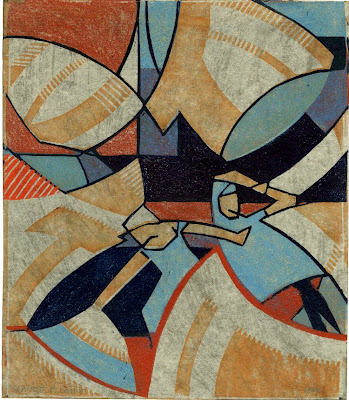Thursday, 13 September 2012
Claude Flight: a linocut evangelist
Claude Flight had a nice line in pithy sayings. 'I am a lone figure, belonging to no school' was one of his most self-conscious. Ironically, the modern print industry has nevertheless attached his name to one very famous school. I mean the Grosvenor. He worked there weekly, for no more than four years, between 1926 and 1930, but his life and career have largely been subordinated to it by people who have one of two things in mind: their own careers or their bank accounts. Fortunately, his linocuts, like the one above, are as radical as those things are conventional.
I very much like the way you can read almost everything that has happened on the sheet of paper. He even put the price on them although the photographs don't show the £2 - 2s - 0d. This was alot more more than the average man's daily beer Flight claimed his prints might cost (unless he knew alot of average with way-above-average alcohol habits, that is) but then he certainly wouldn't be a lone figure when it came to fatuous remarks. The top sheet, as you can see, isn't even square. Nor is the print. The overprinting is smudged way beyond the image - if you can actually say where the image ends. Interconnection, though, is the name of the game. The figures become part of some unseen field of force that appears to include their environment. There is an even more remarkable attempt to define the second image by ruling lines with a pencil, the whole approach as outlandish as it was deliberate. Why?
Again, ironically, it was the whole commercial printmaking set-up that he had in his sights. His prints are quite simply the exact opposite of the fine etchings of the period that cost so much and meant so little. I won't name names, but the whole thing basically was a racket.
It's hard to say whether Flight was conscious of that other lone prophet, crying in the wildnerness. He had joined the Seven and Five Society alongside other artists with a modern outlook in 1923 but was subsequently eased out when the advanced Ben Nicholson began to insist on abstraction for all. Flight must have found it galling to discover that prints like the one above were not modern enough.
Clearly, it was easy enough, even at the time, to pick holes in Flight. The Studio never published one of his prints, denigrating them as design. (They showed rugs by Flight and Gertrude Lawrence instead). His aesthetics were in tatters before he had even put pen to paper. He took exception to Frank Morley Fletcher saying lino could not produce 'a beautiful surface' but viewed prints from a press as 'deplorably mechanical' and 'works of art of a very low order'. But, in the end, it was the example that he set that was perhaps as important as the prints that he made. By all accounts, he was a charismatic teacher who obviously brought out the best in many students. Sybil Andrews said that making the prints were by no means as straightforward as Flight liked to make out, and the work of some of his students at least ended up looking alot like him. Yet I wonder how many of them actually stuck their tissue images to an olive-green backing mount so the green might show through as he did with Trawler down the wave, above. It's a real shame you can't see this in the photo. It looks much better without its mount, than it does enclosed. And as soon as you see it in front of you, all the clap-trap is forgotten (if not entirely forgiven).
Labels:
Flight Claude
Subscribe to:
Post Comments (Atom)




Unseen prints and inside information. A treat !
ReplyDeleteThanks.
And I am off on another trawl tomorrow.
ReplyDeleteThanks, Clive. To some extent this little group of prints come across as period and propagandist but the main point is that Flight's whole career should be looked at. Some modern appraisals have been little more than cherry-picking. His wartercolours are fairly conventional, for instance.
ReplyDeleteDominic Winter (Auctioneers) Limited are holding a Fine Art Auction on Wednesday 16th July at 11 am including British & Continental Etchings, Woodcuts & Lithographs by artists such as Kenneth Broad, Claughton Pellew and William Lee Hankey, etc. www.dominicwinter.co.uk
ReplyDelete